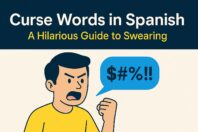Spanish homographs: Nouns spelled identically to conjugated verbs

Get our free email course, Shortcut to Conversational.
Have conversations faster, understand people when they speak fast, and other tested tips to learn faster.
More infoIf you’ve been following our posts you probably already know about Spanish homonyms, which are words that have the same spelling and/or the same pronunciation, but different meanings.
Spanish homographs and homophones are two types of homonyms. Homographs share identical spelling but have different meanings, and sometimes different pronunciations. Homophones share pronunciation but have different meanings; homophones can have different spellings, or they can also be homographs and have identical spelling too.
Among the Spanish homographs, some happen to be nouns that are spelled the same as conjugated verbs. Although some of these homographs have related meanings, in other instances they lack any semantic connection. Regardless, this linguistic quirk is very interesting, and the similarities in writing can can cause confusion for Spanish learners and native speakers alike.
So in today’s post, we’ll focus on this specific subgroup of homographs in Spanish: nouns that are identical to a conjugated verb. We’ll divide them into nouns that match first-person conjugated verbs and third-person conjugated verbs, and present you with some examples to see them in context and learn to differentiate them.
Let’s start learning!
Nouns that are spelled the same as first-person conjugated verbs
In this section we’ll cover some nouns spelled the same as first-person conjugated verbs. One thing to consider about these Spanish homographs is that most are homophones as well, meaning that besides spelling, they also share pronunciation.
Although the spellings are technically different when one word has an accent and the other doesn’t, we’re still including several of these pairs since they’re so similar. These ones aren’t quite homophones, however, since Spanish accent marks indicate syllable stress and can mark the distinction in pronunciation between words.
| Noun | English | Verb | English |
| El canto | Song, Singing | (Yo) Canto | I sing |
| El médico | Doctor | (Yo) Medico | I medicate |
| El piso | Floor | (Yo) Piso | I step on, I walk |
| El público | Public | (Yo) Publico | I publish |
| El número | Number | (Yo) Numero | I number |
| El torno | Lathe | (Yo) Torno | I turn, return |
El canto vs Canto
Song, Singing vs I sing (cantar, conjugated in present simple)
- El canto de los niños siempre me pone de buen humor. – The singing of children always gets me in a good mood.
- El canto es una herramienta poderosa para hacer menos tedioso el trabajo. – Song is a powerful tool to make work less tedious.
- Canto en el coro de la iglesia junto con mis hermanas. – I sing in the church choir with my sisters.
El médico vs Medico
Doctor (male) vs I medicate (medicar, conjugated in present simple)
- El médico me recetó ibuprofeno y descanso. – The doctor prescribed me ibuprofen and rest.
- Medico a los pacientes porque soy enfermera y estoy capacitada para hacerlo. – I medicate patients because I am a nurse and I am trained to do so.
El piso vs Piso
Floor, Apartment vs I step on, I walk (pisar, conjugated in present simple)
- El piso está resbaloso porque está mojado. – The floor is slippery because it is wet.
- Quiero alquilar el piso por tres meses. – I want to rent the apartment for three months.
- Piso el pedal con fuerza porque está dañado. – I step on the pedal firmly because it is damaged.
El público vs Publico
The public vs I publish, I reveal (publicar, conjugated in present simple)
- El público se sorprendió mucho cuando se reveló la enfermedad del presidente. – The public was very surprised when the president’s illness was revealed.
- Publico artículos de opinión en el periódico local. – I publish opinion pieces in the local newspaper.
El número vs Numero
Number vs I number (numerar, conjugated in present simple)
- El número de personas con dificultades visuales va en aumento. – The number of visually impaired people is increasing.
- ¿Tienes el número de María Eugenia? Debo llamarla hoy. – Do you have María Eugenia’s number? I must call her today.
- Numero las sillas de los invitados para que todos sepan dónde sentarse en la boda. – I number the guests’ chairs so that everyone knows where to sit at the wedding.
El torno vs Torno
Lathe vs I turn, I return (tornar, conjugated in present simple)
- El torno es una invención muy antigua para trabajar la madera. – The lathe is a very ancient invention for working with wood.
- Yo torno a mi morada lleno de nostalgia y emoción después de un largo viaje. – I return to my home full of nostalgia and emotion after a long journey.
Nouns that are spelled the same as third-person conjugated verbs
This group of Spanish homographs follows the same principle as the previous group, with the difference that the nouns match verbs conjugated in the third person instead. Most of them are regular, conjugated in simple present. Just like the previous group, some pairs are also homophones, except for those differentiated by accent marks.
| Noun | English | Verb | English |
| La sopa | Soup | (Él, Ella, Usted) Sopa | He/She dips, dunks; You dip, dunk |
| La línea | Line | (Él, Ella, Usted) Linea | He/She lines, sketches; You line, sketch |
| La pesa | Dumbbell | (Él, Ella, Usted) Pesa | He/She weighs; You weigh |
| La pila | Battery, Pile | (Él, Ella, Usted) Pila | He/She threshes; You thresh |
| La raya | Line, Stripe, Stingray | (Él, Ella, Usted) Raya | He/She marks; You mark |
| La mina | Mine | (Él, Ella, Usted) Mina | He/She mines; You mine |
| El vino | Wine | (Él, Ella, Usted) Vino | He/She/You came |
| El corte | Cut | (Él, Ella, Usted) Corte | He/She cuts; You cut |
La sopa vs Sopa
Soup vs He/She dips, He/She dunks [for example, bread in milk or sauce] (sopar, conjugated in present simple)
- La sopa de tomate que hace mi mamá es mi favorita. – The tomato soup my mom makes is my favorite.
- Ella sopa el pan en la leche antes de comérselo. – She dips the bread in the milk before eating it.
La línea vs Linea
Line vs He/She lines, He/She sketches (linear, conjugated in present simple)
- Sigue la línea punteada para completar la figura. – Follow the dotted line to complete the figure.
- El pintor linea los trazos de lo que será su próxima obra maestra. – The painter sketches the outlines of what will be his next masterpiece.
La pesa vs Pesa
Dumbbell vs He/She weighs (pesar, conjugated in present simple)
- Esta es la pesa ideal para realizar ese ejercicio. – This is the ideal dumbbell for this exercise.
- La niña pesa 30 kilogramos. – The girl weighs 30 kilograms.
La pila vs Pila
Battery, Pile vs He/She threshes [cereals or grains] (pilar, conjugated in present simple)
- La pila de mi teléfono se descarga muy rápido. – My phone battery drains very quickly.
- La pila de trabajo que tengo por hacer crece cada día. – The pile of work I have to do grows every day.
- Él pila el maíz para hacer las arepas. – He threshes the corn to make the arepas.
La raya vs Raya
Line, Stripe, Stingray vs He/She marks (rayar, conjugated in present simple)
- La raya blanca de su camiseta es muy llamativa. – The white stripe on his T-shirt is very flashy.
- La raya es un animal que vive en el océano. – The stingray is an animal that lives in the ocean.
- Luisa raya mi brazo con un marcador cada vez que me ve. – Luisa draws on my arm with a marker every time she sees me.
La mina vs Mina
Mine vs He/She mines (minar, conjugated in present simple)
- La mina de carbón cerró hace veinte años. – The coal mine closed twenty years ago.
- Pedro mina datos para la empresa donde trabaja. – Pedro mines data for the company where he works.
El vino vs Vino
Wine vs He/She came (venir, conjugated in simple past)
- Mi hermano me trajo el vino de mora que le pedí. – My brother brought me the blackberry wine I asked for.
- Mi hermano vino a desayunar conmigo esta mañana. – My brother came to have breakfast with me this morning.
El corte vs Corte
Cut, Haircut vs He/She cuts (cortar, conjugated in present subjunctive)
- El corte que se hizo en la mano necesita puntos. – The cut she got on her hand needs stitches.
- Espero que ella corte mi cabello. – I hope she cuts my hair.
Conclusion
Great job! Today we reviewed a nice list of Spanish homographs where a noun is spelled the same as a conjugated verb. To wrap up, let’s just do a quick review of what we learned.
First, let’s remember that homographs are a type of homonyms where words share the same spelling. In this post, we introduced nouns that are spelled identically to conjugated verbs. Some differ just in the presence or absence of an accent mark, being otherwise identical.
We broke our list down into two groups based on the grammatical person to which the verb is conjugated: first-person and third-person. In first person all were conjugated in the simple present, while in the third person we also saw a couple of other tenses.
While some of these Spanish homographs have similar meanings, such as una mina (a mine) and the conjugated verb mina (he/she mines), others lack semantic connections, such as el vino (wine) and vino (he/she came). For every Spanish homograph pair, we provided examples to see each word in context to be able to spot the difference right away.
Learning about linguistic quirks like this one offers a great opportunity to better understand the nuances behind the language, and sharpen your Spanish skills. Keep practicing and see you in the next post!



